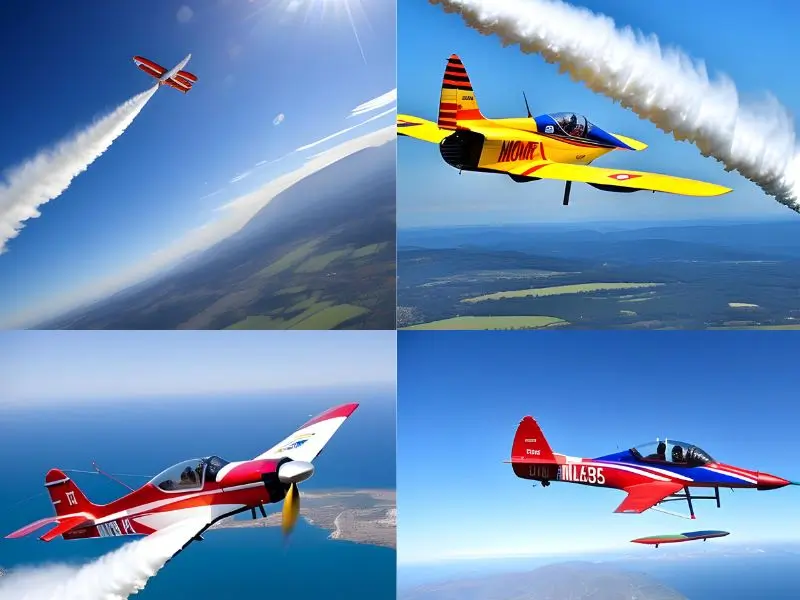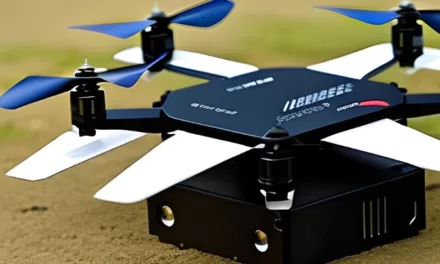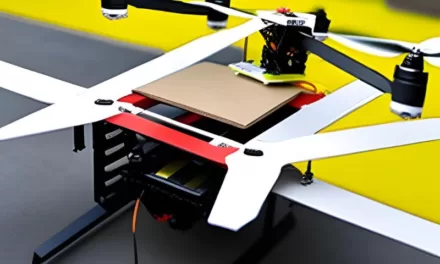Definition of Aerobatics: Aerobatics, also known as acrobatics or stunt flying, is a thrilling form of aviation that involves performing precise and gravity-defying maneuvers in the sky. Pilots control their aircraft through a series of complex twists, turns, rolls, and loops, pushing the boundaries of physics and showcasing their skill and mastery of the craft.
The Thrill and Skill of Aerobatic Flying
There is an undeniable excitement that comes with aerobatic flying. The adrenaline rush of executing daring maneuvers combined with the sense of freedom above the clouds is unmatched. It requires immense skill, dedication, and discipline to master the art of aerobatics.
The Importance of Proper Training
Before attempting any aerobatic maneuvers, it is crucial to undergo comprehensive training with a certified flight instructor. Proper instruction ensures pilots learn the techniques, safety protocols, and situational awareness required for safe and successful aerobatic flights.
Understanding the Basics:
Principles of Aerodynamics
To excel in aerobatics, pilots must grasp the fundamental principles of aerodynamics that govern the behavior of their aircraft during maneuvers. Knowledge of lift, drag, thrust, and weight is essential to perform maneuvers with precision.
Types of Aerobatic Aircraft
Different aircraft are designed for specific aerobatic maneuvers. From basic trainers to high-performance aerobatic aircraft, each type serves unique purposes in the world of aerobatics.
Safety Precautions and Equipment
Safety is paramount in aerobatics. Pilots must adhere to strict safety protocols and use specialized equipment like parachutes and harnesses to mitigate risks during extreme maneuvers.
Building a Solid Foundation:
Mastering Straight and Level Flight
Before diving into complex maneuvers, pilots must learn to maintain steady, straight, and level flight, which forms the foundation of aerobatics.
Introduction to Basic Maneuvers
- Loop: The loop is a classic aerobatic maneuver where the aircraft flies in a vertical circle, tracing a path that resembles the shape of a loop.
- Roll: The roll involves rotating the aircraft around its longitudinal axis, producing a series of consecutive barrel rolls.
- Immelmann Turn: This maneuver combines a half loop with a half roll, resulting in a reversal of direction and a level flight at a higher altitude.
Progressing to Intermediate Aerobatics:
- The Art of the Barrel Roll: The barrel roll is a more advanced variation of the basic roll, involving a combination of roll and loop elements to create a graceful spiral.
- Snap Roll: The Quick and Precise Movement: The snap roll demands rapid and controlled rotation around the aircraft’s lateral axis, requiring precise timing and coordination.
- Inverted Flight and Its Challenges: Inverted flight involves flying upside down, which presents unique control challenges for pilots.
- The Dynamic Split-S and Reverse Half Cuban Eight: The split-S and reverse half Cuban Eight are complex maneuvers that test a pilot’s skill in executing intricate combinations of rolls and loops.
Advanced Aerobatics:
- Pushing the Limits with the Lomcovak: The Lomcovak is a series of consecutive tumbles and spins, showcasing the pilot’s ability to control the aircraft in seemingly chaotic movements.
- The Tumbling Torque Roll: The tumbling torque roll involves controlled tumbling in a slow forward movement, displaying mastery over all three axes of flight.
- High-G Turns and Positive/Negative Snap Maneuvers: High-G turns and snap maneuvers demand physical and mental endurance as pilots endure high gravitational forces while executing rapid direction changes.
Mastering the Knife Edge:
- Knife-Edge Flight Fundamentals: Maintaining the aircraft in knife-edge flight requires precise control to balance lift and maintain a horizontal flight path on the aircraft’s side.
- The Knife-Edge Loop: The knife-edge loop is a challenging maneuver combining a vertical climb with a knife-edge flight path.
- The Knife-Edge Spin: The knife-edge spin involves performing a spin while maintaining a knife-edge flight attitude.
Creating Your Aerobatic Routine:
- Choreographing the Sequence: Crafting an impressive aerobatic routine involves selecting maneuvers that flow smoothly from one to another, creating an engaging and captivating performance.
- Balancing Difficulty and Showmanship: A well-balanced routine strikes a perfect blend of technical difficulty and crowd-pleasing showmanship.
- The Importance of Transitions: Seamless transitions between maneuvers enhance the fluidity and overall aesthetics of an aerobatic routine.
Mental Preparation and Focus:
- Developing Concentration and Awareness: Aerobatic flying demands intense focus and awareness of the aircraft’s position and attitude.
- Visualization Techniques: Mentally rehearsing maneuvers through visualization helps pilots familiarize themselves with each step, enhancing muscle memory.
- Handling Fear and Nerves: Overcoming fear and nerves is crucial to maintaining composure during high-stress aerobatic performances.
Physical Conditioning for Aerobatics:
- Core Strength and Flexibility: A strong core and flexible body aid in maintaining control during the extreme forces experienced in aerobatics.
- Endurance and Cardiovascular Training: Aerobatic flights can be physically demanding, requiring pilots to be in good cardiovascular shape and endurance.
- Nutrition and Hydration: Proper nutrition and hydration support pilots’ physical and mental performance during aerobatic training and performances.
Advanced Training and Coaching:
- Seeking Professional Instruction: Continued learning from experienced instructors is essential for advancing aerobatic skills.
- Participating in Aerobatic Competitions: Competing in aerobatic competitions challenges pilots to perform at their best and receive valuable feedback from judges.
- Learning from Mistakes and Constant Improvement: Understanding and learning from mistakes is an integral part of becoming a skilled aerobatic pilot.
Embracing the Joy of Aerobatics:
- The Feeling of Freedom in the Skies: Aerobatics offers a unique sense of liberation as pilots defy gravity and soar through the skies.
- Joining the Aerobatic Community: Being part of the aerobatic community provides support, camaraderie, and opportunities for growth.
- Spreading the Passion for Aerobatic Flying: Sharing the joy and excitement of aerobatics with others fosters a greater appreciation for this exhilarating form of aviation.
Conclusion:
- Reflecting on the Journey: The journey of mastering aerobatics is one of dedication, challenges, and triumphs.
- Encouraging Others to Pursue Aerobatics: Inspiring others to explore the world of aerobatics brings a sense of fulfillment and purpose.
- Embracing the Adventure of Aerobatic Flying: Aerobatics is not just a skill; it’s an adventure that pushes boundaries and allows pilots to discover the full potential of flight.
Aerobatics: FAQs
What is aerobatics, and how is it different from regular flying?
Aerobatics is a form of aviation that involves performing intricate maneuvers, such as rolls, loops, and spins, to showcase the pilot’s skill and precision. Unlike regular flying, which focuses on standard flight procedures and navigation, aerobatics requires advanced control and mastery of the aircraft to execute gravity-defying moves.
Is mastering aerobatics only for experienced pilots?
While aerobatics can be challenging and demanding, it is not limited to experienced pilots. Anyone with a passion for aviation and dedication to learning can venture into aerobatics. However, it is crucial to undergo proper training with a certified flight instructor to ensure safety and skill development.
What are the essential aerodynamic principles for aerobatic maneuvers?
Aerobatic maneuvers heavily rely on four key aerodynamic principles: lift, drag, thrust, and weight. Understanding how these forces interact with the aircraft during different maneuvers is fundamental to mastering aerobatics.
How do I choose the right aerobatic aircraft for training?
Selecting the right aerobatic aircraft depends on factors such as your skill level, budget, and training goals. Basic aerobatic trainers are suitable for beginners, while high-performance aerobatic aircraft are designed for more experienced pilots seeking greater maneuverability.
What safety precautions should I follow during aerobatic flights?
Safety is paramount in aerobatics. Always wear appropriate safety gear, follow pre-flight checklists meticulously, stay within your skill level, and maintain proper altitude and airspace clearances to ensure safe aerobatic flights.
What are the basic aerobatic maneuvers I need to learn first?
Mastering straight and level flight is the foundation of aerobatics. After that, focus on basic maneuvers like loops, rolls, and the Immelmann Turn to build your aerobatic skills progressively.
How can I improve my straight and level flight skills?
Practice maintaining a constant altitude and heading while minimizing control inputs. Use visual references and pay attention to your aircraft’s attitude to refine your straight and level flying technique.
What are some tips for executing a perfect loop maneuver?
To perform a loop, apply full back pressure to initiate the climb, and then smoothly roll the aircraft inverted at the top of the loop. Maintain coordination and control throughout the maneuver to complete a precise loop.
How can I perform precise rolls during aerobatics?
Executing precise rolls requires coordinated aileron and elevator inputs. Avoid abrupt control movements and practice maintaining a constant roll rate to achieve smooth and accurate rolls.
What is the Immelmann Turn, and how do I master it?
The Immelmann Turn is a combination of a half loop, followed by a half roll. Mastering this maneuver involves maintaining proper airspeed and altitude control while smoothly transitioning from the climb to level flight.
What are intermediate aerobatic maneuvers, and how do I progress to them?
Intermediate aerobatic maneuvers are more complex than the basics and include barrel rolls, snap rolls, inverted flight, and split-S maneuvers. Gradually progress to these maneuvers as you gain confidence and proficiency in basic aerobatics.
How do I perform a barrel roll with finesse?
To execute a barrel roll, apply coordinated aileron and elevator inputs while maintaining a consistent roll rate. Focus on keeping the loop symmetrical for a graceful barrel roll.
What are snap rolls, and how can I execute them safely?
Snap rolls are rapid and precise rotations around the lateral axis. Practice snap rolls under the guidance of an experienced instructor, as they require precise timing and recovery techniques to ensure safety.
What challenges should I be aware of during inverted flight?
Inverted flight presents unique challenges, including inverted vision and control reversal. Pilots must adapt to these changes and maintain precise control to perform maneuvers safely.
How do I master the dynamic Split-S and Reverse Half Cuban Eight?
The dynamic Split-S combines a half roll with a half loop, while the Reverse Half Cuban Eight is a combination of a half loop and a half roll in the opposite direction. These maneuvers require precise control and smooth coordination to perform well.
What are some advanced aerobatic maneuvers for skilled pilots?
Advanced aerobatic maneuvers include the Lomcovak, tumbling torque roll, high-G turns, and positive/negative snap maneuvers. These maneuvers test a pilot’s expertise and control over the aircraft.
How do I perform the Lomcovak, and what are the risks involved?
The Lomcovak involves a series of consecutive tumbles and spins. Performing this maneuver demands exceptional skill and situational awareness, as it carries inherent risks.
What is the technique behind the tumbling torque roll?
The tumbling torque roll requires mastery of all three axes of flight as the aircraft tumbles while moving forward. Skilled coordination and control are necessary to execute this advanced maneuver.
How can I execute high-G turns and positive/negative snap maneuvers?
High-G turns and snap maneuvers demand physical and mental endurance, as pilots endure high gravitational forces while performing rapid direction changes.
What is the knife-edge flight, and how can I maintain it smoothly?
Knife-edge flight involves flying the aircraft on its side. Precise rudder and aileron control are necessary to maintain a stable knife-edge flight path.
How do I perform a knife-edge loop, and what are the challenges?
Performing a knife-edge loop requires maintaining a consistent knife-edge flight attitude while executing a vertical climb. Maintaining proper control during the maneuver can be challenging.
What is a knife-edge spin, and how do I recover from it?
A knife-edge spin involves entering a spin while maintaining the aircraft in knife-edge flight. Proper recovery techniques are essential to exit this spin safely.
How can I create my own aerobatic routine for performances?
Creating an aerobatic routine involves selecting maneuvers that flow seamlessly and captivate the audience. Consider difficulty, showmanship, and transitions to craft an engaging routine.
What should I consider when balancing difficulty and showmanship?
A well-balanced routine strikes a perfect blend between challenging maneuvers to showcase skill and audience-pleasing moves that entertain and awe.
What makes seamless transitions between maneuvers important?
Smooth transitions enhance the fluidity and aesthetic appeal of an aerobatic routine, making it more visually appealing and captivating to spectators.
How can I improve my concentration and awareness during aerobatics?
Focus on the task at hand and practice mindfulness techniques to enhance concentration and situational awareness while performing aerobatic maneuvers.
What visualization techniques can aid in mastering aerobatic moves?
Mental rehearsal through visualization can help pilots familiarize themselves with each aerobatic maneuver, enhancing muscle memory and execution.
How do I overcome fear and nervousness before aerobatic flights?
Address fear and nervousness through proper mental preparation, positive self-talk, and trust in your training and abilities as a skilled pilot.
What physical conditioning is essential for aerobatics?
Aerobatics demands physical strength, flexibility, and endurance. Focus on core exercises, cardiovascular training, and a balanced diet to prepare your body for the challenges of aerobatic flying.
Where can I find professional training and coaching for aerobatics?
Look for certified flight schools and experienced aerobatic instructors to receive comprehensive training and coaching for mastering aerobatics safely and effectively.




